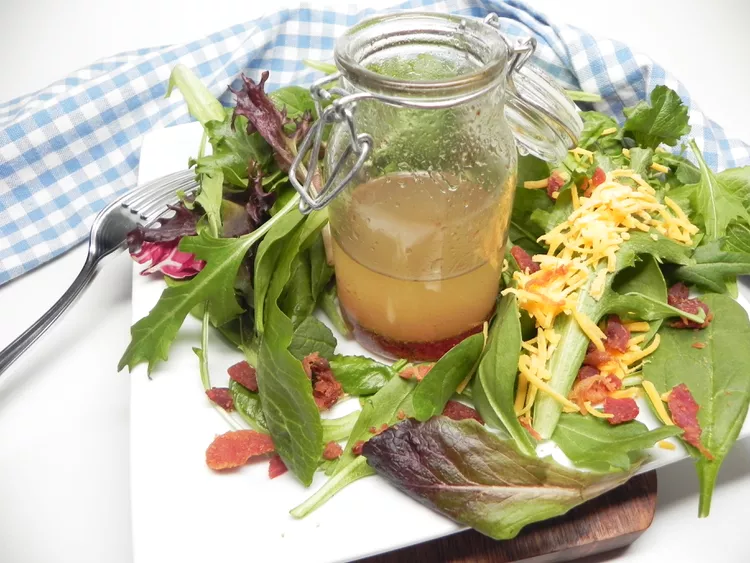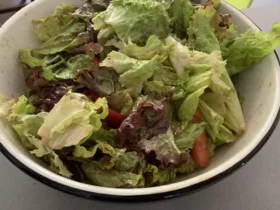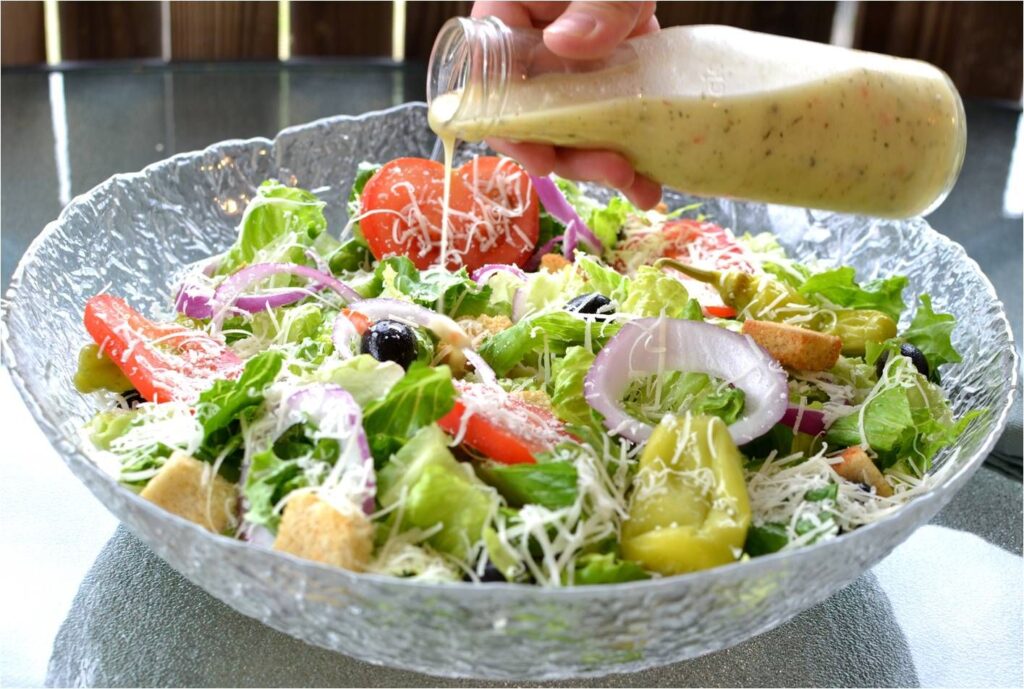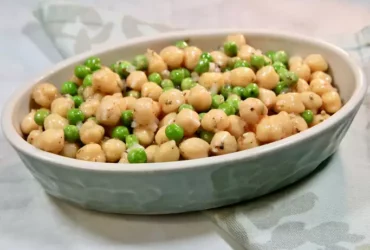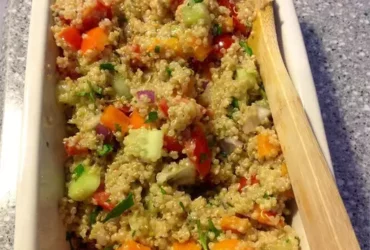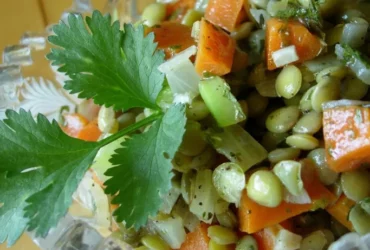Ingredients
The Basics
The foundation of any delicious salad lies not only in its composition but also in the dressing that brings all the flavors together. In this article, we will focus on the essential ingredients required for making the easiest salad dressing recipe.
Essential Ingredients
- Olive Oil
- Red Wine Vinegar (or Apple Cider Vinegar)
- Dijon Mustard
- Sugar or Honey
- Seasonings (Salt and Pepper)
The key to making this dressing is to use the right balance of ingredients. The ratio can vary based on your personal taste preferences, but a general guideline starts with equal parts olive oil and vinegar. Add a pinch of salt, pepper, a dash of mustard for creaminess, and a touch of sugar or honey to round out the flavors.
Customizing Your Dressing
The beauty of this recipe lies in its flexibility. Feel free to add your favorite herbs or spices to make it unique. Some suggestions include: minced garlic for an added savory flavor, dried oregano for a Greek twist, or even chopped fresh dill for a bright, summer feel.
Tips and Tricks
When mixing your ingredients, start with the wet components (vinegar, mustard, sugar/honey) in a bowl before slowly pouring in the olive oil. This helps emulsify the dressing, preventing separation over time. Taste as you go to adjust seasoning to your liking.
Storing Your Dressing
Once you’ve created your perfect blend, store it in an airtight container in the refrigerator for up to 5 days. Give it a good stir before using each time, and be sure to shake well after adding any ingredients that may have settled.
The Easiest Salad Dressing Recipe
Here’s a simple recipe based on our discussion of ingredients:
- 1/4 cup olive oil
- 1/4 cup red wine vinegar (or apple cider vinegar)
- 1 teaspoon Dijon mustard
- 1 teaspoon sugar or honey
- A pinch of salt and pepper to taste
Mix the wet ingredients first, then slowly add the olive oil while continuously whisking. Adjust seasoning as needed.
This is a basic recipe that can be adapted in countless ways. Experiment with different combinations to find your new favorite dressing!
2 tablespoons olive oil
The first ingredient that plays a crucial role in creating the easiest salad dressing recipe is olive oil. Specifically, we need two tablespoons of this healthy fat to add depth and richness to our dressing.
Olive oil is an essential component of many Mediterranean-style dressings, and for good reason. It has a distinct flavor that pairs well with the natural sweetness of fresh vegetables, while also providing numerous health benefits due to its high levels of antioxidants and heart-healthy monounsaturated fats.
When selecting an olive oil for our dressing, it’s best to choose a mild or light variety. This will help prevent any overpowering flavors that might detract from the overall taste of our salad. A mild olive oil will also allow other ingredients, such as lemon juice and herbs, to shine through in our finished dressing.
In terms of quality, it’s worth investing in a high-quality, extra-virgin olive oil for this recipe. Not only will it provide the best flavor, but it will also ensure that our dressing is made with the finest ingredients possible.
When incorporating olive oil into our salad dressing, make sure to use a light hand at first. We can always add more oil, but it’s harder to remove excess oil from the mixture once it’s been added.
1 tablespoon apple cider vinegar or lemon juice
When it comes to making a delicious salad dressing, one of the key ingredients is the acid component that helps to bring out the flavors of the other ingredients and balance the richness of the dressing.
In this recipe for Easiest Salad Dressing, we’re using either apple cider vinegar or lemon juice as our acid component. Both of these options are great choices because they add a tangy flavor to the dressing without overpowering the other ingredients.
Apple Cider Vinegar is a type of vinegar made from fermented apples, and it has a slightly sweet and tart flavor that pairs well with many different types of greens. It’s also a good choice if you want a slightly sweeter salad dressing because some brands of apple cider vinegar have a hint of sweetness to them.
Lemon Juice, on the other hand, is a classic choice for salad dressings and adds a bright, citrusy flavor that complements many types of greens. Freshly squeezed lemon juice is always preferred over bottled lemon juice because it has a more vibrant flavor and can be adjusted to taste.
When using either apple cider vinegar or lemon juice, start with one tablespoon as the recipe suggests, and adjust to taste. Some people prefer their salad dressings more acidic, while others like them milder. You can always add more acid component if needed, but it’s harder to remove excess acidity from the dressing.
So, whether you choose apple cider vinegar or lemon juice, both will add a delicious and tangy flavor to your salad dressing that’s sure to please even the pickiest eaters!
1 teaspoon Dijon mustard
Dijon mustard is a type of mustard that originates from Dijon, France. It is made from brown and white mustard seeds that have been finely ground and mixed with water, salt, and spices. The resulting paste has a smooth and creamy texture, with a slightly spicy flavor.
The key characteristic of Dijon mustard is its mild, slightly sweet taste, which sets it apart from other types of mustard. It has a tangy flavor that complements a wide range of ingredients, making it an excellent addition to many recipes, including salad dressings.
In the context of the Easiest Salad Dressing Recipe, Dijon mustard serves as a key ingredient in adding depth and complexity to the dressing’s flavor profile. Its creamy texture also helps to emulsify the other ingredients, creating a smooth and consistent consistency in the final product.
What is Dijon Mustard Used For?
Dijon mustard is a versatile condiment that can be used in a variety of dishes beyond salad dressings. Some popular uses include:
- Cooking: Add a teaspoon or two to soups, stews, and sauces for added flavor.
- Marinades: Mix with olive oil, vinegar, and herbs to create marinades for meats and vegetables.
- Sandwiches: Spread on sandwiches for a tangy, savory flavor.
Why Use 1 Teaspoon of Dijon Mustard in the Salad Dressing Recipe?
The use of 1 teaspoon of Dijon mustard in the Easiest Salad Dressing Recipe serves several purposes:
- Adds depth and complexity to the dressing’s flavor profile.
- Helps to emulsify the other ingredients, creating a smooth consistency.
- Provides a tangy, slightly sweet taste that complements the other flavors in the recipe.
Salt and pepper to taste
The ingredients required for this simplest salad dressing recipe are minimal, yet crucial in bringing out the flavors and textures of your favorite greens.
The first essential ingredient is olive oil, which provides a smooth and velvety base to our dressing. Choose a high-quality olive oil with a mild flavor that won’t overpower the other ingredients.
Next, we need vinegar, which adds a tangy and refreshing taste to balance out the richness of the olive oil. You can use either wine vinegar or , depending on your personal preference.
A pinch of salt is necessary to bring out the flavors of the other ingredients and add depth to the dressing. Use a flaky sea salt or kosher salt for the best results.
Finally, we have pepper, which adds a subtle but essential spice to our dressing. Use freshly ground black pepper for the best flavor.
Remember, when using salt and pepper to taste, it’s all about balance and harmony. Start with a small amount and adjust to your liking, as you can always add more salt or pepper but it’s harder to remove excess seasoning.
Optional: garlic powder, paprika, or other herbs for added flavor
The key to a great salad lies not just in its ingredients, but also in the dressing that brings everything together. In this recipe for the easiest salad dressing, we’ll focus on the essential ingredients and explore some optional additions to give your salad an extra boost of flavor.
For a classic vinaigrette-style dressing, you’ll need:
- 2 tablespoons olive oil: This is the base of our dressing, providing a smooth and velvety texture.
- 2 tablespoons apple cider vinegar or white wine vinegar: These acidic ingredients help to balance out the richness of the oil and add a tangy flavor.
- 1 teaspoon Dijon mustard: This adds a creamy and slightly spicy kick to our dressing, complementing the flavors of the oil and vinegar.
Now, let’s talk about some optional ingredients that you can add to give your salad an extra layer of flavor:
- Garlic powder: Add a pinch (about 1/4 teaspoon) of garlic powder to give your salad a savory and aromatic flavor.
- Paprika: A mild, sweet spice that adds depth to our dressing. Start with a small amount (about 1/8 teaspoon) and taste as you go.
Other herbs like dried thyme or oregano can also be added in small amounts (about 1/4 teaspoon) to complement the flavors of your salad. Feel free to experiment and find the perfect combination for your taste buds!
Remember, the beauty of this recipe lies in its simplicity and flexibility. You can adjust the proportions of our base ingredients to suit your taste preferences, and add or subtract optional ingredients as you see fit.
With these essential and optional ingredients, you’ll be well on your way to crafting a delicious salad dressing that will elevate any green to a new level of flavor and enjoyment!
Instructions
Mixing the Dressing
Making salad dressing at home can be a fun and rewarding experience, especially when you follow clear and concise instructions. The key to making great salad dressing is to start with high-quality ingredients and to mix them together in the right proportions.
When mixing salad dressing, it’s essential to emulsify, which means combining two or more liquids that don’t normally mix together, such as oil and vinegar. This process creates a smooth, creamy texture that coats the leaves of the salad evenly.
To emulsify, you need to introduce the ingredients in the right order. Typically, you want to add the acidic ingredient (such as vinegar or lemon juice) first, then slowly pour in the oil while constantly whisking or blending the mixture.
The acidity helps to break down the droplets of fat in the oil, allowing them to mix with the other ingredients and creating a stable emulsion. This process is called “building the emulsion.”
Once you have built the emulsion, you can add any additional flavorings or spices that you like. Some common additives include minced garlic, Dijon mustard, and chopped fresh herbs like parsley or dill.
To store your homemade salad dressing, make sure to keep it in an airtight container in the refrigerator at all times. You can also consider dividing it into smaller portions and freezing them for later use.
When you’re ready to serve the salad, simply pour some of the dressing over the leaves and toss to coat. Be careful not to overdress the salad, as this can make it too soggy or overpowering.
By following these simple steps and using high-quality ingredients, you can create delicious homemade salad dressings that are tailored to your taste preferences.
In a small bowl, whisk together olive oil, vinegar or lemon juice, Dijon mustard, salt, and pepper until smooth.
In a small bowl, whisk together olive oil, vinegar or lemon juice, Dijon mustard, salt, and pepper until smooth.
This instruction provides a clear and concise guide on how to prepare a simple salad dressing using basic pantry ingredients. The key elements of this instruction are:
Clear identification of the ingredients: The ingredients required for the dressing are listed explicitly, making it easy for the reader to understand what is needed.
Specific quantities not mentioned: This implies that the proportions of each ingredient should be adjusted according to personal taste.
Whisking as a mixing method: Whisking is an effective way to combine the ingredients thoroughly and ensure they are well incorporated, which is particularly important when working with acidic elements like vinegar or lemon juice.
To make this instruction even more comprehensive, it could include:
Optional variations for added flavor: Mentioning other seasonings or spices that can be added to create different flavor profiles.
Tips for adjusting the consistency: Suggesting ways to adjust the dressing’s thickness by adding more oil, vinegar, or water.
Safety precautions when handling acidic ingredients: Providing a warning about the potential for splashing and offering suggestions for minimizing risk.
By following these guidelines, anyone can easily create their own salad dressing using this recipe.
Taste and adjust seasoning as needed – add more vinegar for tanginess or more mustard for a spicier kick.
The process of taste and adjusting seasoning is an essential step in creating the perfect salad dressing.
This involves a sensory evaluation of the flavor profile, allowing you to fine-tune the balance of flavors to suit your personal preferences.
Here are some specific tips for adjusting seasoning:
- Add more vinegar if you prefer a tangier dressing. Vinegar adds a sharpness and brightness that can elevate the overall flavor experience.
- For an extra kick, add more mustard. Mustard contains a compound called allyl isothiocyanate, which gives it a pungent, slightly spicy taste.
When adjusting seasoning, start with small increments and taste frequently to avoid over-seasoning the dressing. This will allow you to strike a balance between flavors that is both delicious and harmonious.
Some popular combinations for adjusting seasoning include:
- Vinegar and mustard together create a tangy, spicy kick
- A pinch of salt can enhance the flavor and balance out sweet or sour notes
- Adding a drizzle of honey or sugar can counterbalance acidity and add a touch of sweetness
Remember that seasoning is an art, not a science. Experiment with different combinations to find what works best for you, and enjoy the process of crafting the perfect salad dressing.
If using garlic powder or paprika, add a pinch to the dressing for extra depth.
When it comes to adding an extra layer of flavor to your salad dressing, consider incorporating garlic powder or paprika into the mix. These two spices are commonly used in various recipes due to their ability to enhance the overall taste and aroma.
Garlic powder is a dehydrated form of garlic that has been ground into a fine powder. It retains some of the characteristic flavor and aroma of fresh garlic, but without the strong aftertaste and pungency associated with raw garlic. Adding a pinch of garlic powder to your dressing can add depth and richness, making it an excellent choice for those who love garlic without the overpowering taste.
Paprika, on the other hand, is derived from sweet or smoked peppers. It’s often used in savory dishes and adds a sweet, smoky flavor that complements many ingredients. Paprika is particularly well-suited to adding warmth and depth to your salad dressing. You can use either sweet or smoked paprika, depending on the type of flavor you prefer.
To incorporate these spices into your salad dressing, start by measuring out a small pinch (about 1/4 teaspoon) of garlic powder or paprika per cup of dressing. Mix well to ensure the spice is evenly distributed throughout the dressing. You can adjust the amount to suit your personal taste preferences and the type of ingredients you’re using.
Remember that these spices are meant to enhance, rather than overpower, your salad dressing. A small amount goes a long way in adding depth without overwhelming other flavors. Feel free to experiment with different combinations of garlic powder and paprika to find the perfect balance for your taste buds.
Variations
Make it Your Own
Variations are an essential component of creativity and innovation, especially when it comes to developing unique salad dressing recipes.
In the context of this article, variations refer to the different ways in which ingredients can be combined or modified to create distinct flavor profiles and textures.
One of the key aspects of creating successful variations is understanding the basic components of a salad dressing recipe, including acids (such as vinegar or lemon juice), oils, seasonings (like salt, pepper, and herbs), and sweeteners (such as honey or sugar).
By experimenting with different ratios of these components and introducing new ingredients, it’s possible to create a wide range of unique flavors that cater to various tastes and dietary needs.
For instance, adding some grated ginger or garlic can infuse the dressing with an Asian-inspired flavor profile, while using balsamic vinegar instead of regular vinegar creates a richer, sweeter taste experience.
Omitting the sugar or honey entirely and relying solely on acidity from ingredients like citrus or tomatoes can result in a refreshing and tangy vinaigrette perfect for summer salads.
When creating variations, it’s essential to remember that small adjustments can significantly impact the final product, so it’s crucial to taste as you go and make adjustments accordingly.
Some other ideas for variations include experimenting with different types of vinegar (such as apple cider or white wine), adding a pinch of red pepper flakes for an extra kick, or substituting plain Greek yogurt for some or all of the oil to create a creamier dressing.
The possibilities are endless, and embracing the world of variations is an excellent way to keep salad dressing recipes exciting and fresh, even after repeated uses.
For a creamier dressing, whisk in 12 tablespoons of mayonnaise or Greek yogurt.
- Variations on this easy salad dressing recipe can be made to suit individual tastes and preferences, making it an incredibly versatile condiment.
- One way to add creaminess to the dressing is by whisking in a substantial amount of mayonnaise or Greek yogurt.
- The instruction specifies that 12 tablespoons of either ingredient should be incorporated into the mixture, resulting in a significantly thicker and more velvety texture.
- This alteration creates a rich, creamy dressing perfect for those who prefer a heavier consistency.
- For example, individuals with a taste for ranch or Caesar salad dressings may appreciate this variation.
- Additionally, whisking in mayonnaise or Greek yogurt allows the flavors to meld together and intensify, creating a more robust and satisfying experience when eating salads.
- However, those who prefer a lighter dressing can still achieve their desired consistency by adjusting the amount of mayonnaise or yogurt used.
- Ultimately, experimenting with variations on this recipe is an excellent way to explore different flavor combinations and create unique taste experiences for individuals and families.
To make a vinaigrette style dressing, increase vinegar or lemon juice to 2 tablespoons and reduce oil to 1 tablespoon.
One of the key aspects of creating a vinaigrette-style dressing, as described in the article on “Easiest Salad Dressing Recipe”, involves manipulating the proportions of its two primary components: vinegar or lemon juice, and oil.
The instructions for making this type of dressing recommend increasing the amount of vinegar or lemon juice to 2 tablespoons. This alteration serves several purposes:
- It enhances the flavor profile of the dressing by adding a tangier, more acidic taste. Vinegar and lemon juice are both common acidity regulators in salad dressings.
- It helps maintain a balance between the flavors in the dressing. By increasing the amount of vinegar or lemon juice, the sweetness of the sugar (if added) can be balanced, creating a more harmonious flavor experience.
In contrast to increasing the acidity component, the article advises reducing the oil to 1 tablespoon. This adjustment affects several aspects:
- It reduces the overall calorie content of the dressing. Since vinaigrettes are typically lower in fat compared to creamy dressings, this reduction contributes to a healthier option.
- It changes the texture and mouthfeel of the dressing. With less oil, the dressing becomes lighter and easier to drizzle or toss with greens without overpowering them.
The combination of these adjustments—increasing vinegar or lemon juice to 2 tablespoons and reducing oil to 1 tablespoon—enables you to create a vinaigrette-style dressing that not only tastes tangier but also offers a lighter, healthier option for salads.
Experiment with different herbs like basil, oregano, or thyme for unique flavor profiles.
Variations of salad dressing recipes offer endless possibilities to create a unique and delicious taste experience. Experimenting with different herbs such as basil, oregano, or thyme can significantly impact the flavor profile of your salad dressing.
Basil, for instance, adds a sweet and aromatic flavor that pairs well with fresh vegetables like tomatoes and cucumbers. It’s commonly used in Italian and Mediterranean-inspired salads, where its distinctive taste complements the rich flavors of feta cheese and Kalamata olives.
Oregano, on the other hand, brings a pungent and earthy flavor to the table. Its robust taste is often associated with Greek cuisine, particularly when paired with grilled meats like lamb or chicken. In salads, oregano can add depth and warmth, balancing out the brightness of fresh herbs.
Thyme, a more subtle herb, offers a delicate and slightly minty flavor that works well in lighter, fresher salads. It’s commonly used in French cuisine, where it adds a hint of sophistication to dishes like salad Niçoise or a simple green salad with goat cheese.
When experimenting with these herbs, consider the type of salad you’re making and how the herb will interact with other ingredients. For example, if you’re making a Mediterranean-style salad with olives and feta, oregano might be a better choice than basil or thyme.
Remember to start with small amounts of herbs and taste as you go, adjusting the seasoning to your liking. You can always add more herb, but it’s harder to remove excess once it’s added to the dressing.
In addition to these herbs, don’t forget to explore other variations like citrus-herb combinations (e.g., lemon-thyme or orange-basil), spicy elements (e.g., red pepper flakes or sriracha), or sweet and tangy flavors (e.g., honey-mustard). The possibilities are endless, and experimenting with different ingredients will help you create unique salad dressing recipes that suit your taste preferences.
- Best Lusha Alternatives for 2025 - April 22, 2025
- Best Overloop Alternatives for 2025 - April 22, 2025
- Best 6sense Alternatives for 2025 - April 22, 2025

